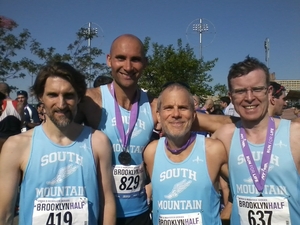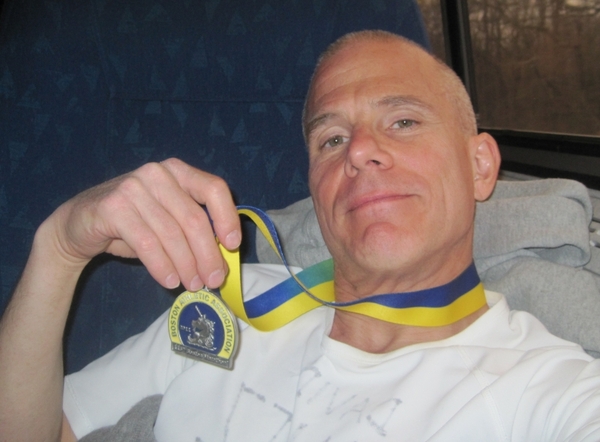I never expected this. For over 20 years I was a typical jogger, going out two or three times a week for about four miles at a leisurely pace. With no goal other than fitness and enjoyment, I was unconcerned about going farther or faster. Suddenly I was 55 years old and lacing up my shoes for my fifth marathon.
It started in the winter of 2008, when a friend with marathon experience invited me to join him for a half marathon in Central Park, and I discovered that I enjoyed running nonstop for two hours. The idea of a marathon, hitherto almost inconceivable, became attractive. In the fall of that same year I ran Philly in 3:51, and loved it. I had the appropriate attitude of humility and respect for the distance, running a disciplined, well-regulated race the likes of which, ironically, I haven’t been able to match ever since.
Next was New York in 2009. By now I had moved to South Orange and fell in with a delightful gang of experienced, enthusiastic, and talented distance runners known as The South Mountain Running Collective. I became ambitious, and wanted to meet the Boston qualifying standard of 3:35. Like a fool, I went out too fast, and had to struggle and suffer to hang on over the last 10K, attaining the goal with only seconds to spare. Going out too fast is the classic mistake in distance running, though you might think it would not be so difficult to avoid.
But this performance got me to Boston in 2011, where I repeated the same error, albeit not as drastically: another positive split, but I beat my goal of 3:20 by five seconds, and easily qualified again for Boston in 2012. (Runners call it a negative split where the second half of a race is faster than the first, and it is well established that it is far more effective than the reverse.)
And how could I resist going back to Boston again? I could not, and trained with a view to another personal record (or PR, which is also a verb in runnerspeak) of about 3:17. But the temperatures were in the high 80s that day in April. We were forced to revise our plans and focus on simple survival. Hence my disappointing 3:43, 13 minutes short of Boston qualification (BQ) for my age group.
By now I was thinking it might be nice to get off the crazy train. Marathon training is a time- and energy-consuming pain in the ass, and try though we might to keep it tucked away in its own discreet little compartment, it inevitably has an impact on other people in our lives. And sometimes those people don’t like it. But could I really go out like that, credible excuse notwithstanding? With a 3:43?
No. In November 2013 I was back in Philadelphia again to settle accounts with the marathon gods. This time, however, the training cycle had been more challenging. It is not unusual to encounter setbacks of some kind during 20 weeks of training. Sickness, injuries, family dramas, the demands of work — in short, life — sometimes interfere. I had successfully navigated through bronchitis, a death in the family, and other challenges in previous training cycles. But this time injuries cost me a week and a half in August and several more days in October, and I was not able to get all the mileage I would have liked.
Even so, when I walked up to the line, I felt fit to run a successful marathon. The key workouts in the final stage of training had gone well. My injuries had subsided, the weather was fine, even my pre-race jitters seemed noticeably less severe than in the past. This time I did not have a fixed, specific goal. I thought 3:15 was conceivable, but decided anything up to 3:17:30 would be acceptable. And I had a plan, known as 10 + 10 + 10: go out relatively conservatively for the first 10 miles, i.e., at a 3:17:30 pace; pick it by a few seconds per mile for the next 10 miles; and for the last 10K, be in a position to pick up the pace even more, possibly enough to get me there in 3:15.
Once we got underway, embarrassing though it is to admit, I am not really sure what I was thinking. I do recall making a conscious effort to hold back initially. Over the first mile, traffic was congested, and I decided to go with it rather than fight. My first mile was a 7:42, but that was perfectly OK. A slow start was desirable; there was plenty of time to make it up.
For the next 18 miles or so, it seemed that nobody was in charge. The data on my GPS watch says that mile 2 was 7:18; mile 3, 7:08. For miles 4 and 5 I dialed it back to 7:24, but that was still about 8 seconds per mile too fast. The next few miles included a couple of moderate ones, and my average pace for the first 10 was around 7:30. The pushing and pulling continued over the second 10 miles, but the average overall was around 7:25 — consistent with the overall plan, yes, but too late because I had already blown too much energy in the first 10. By around mile 17 or 18 I was still feeling OK, but tired enough to predict that after 20 miles it was going to be hard to maintain the pace. Miles 22 to 25 were 7:40, 7:44, 7:48, 7:56, 7:55.
Crossing 26 with the crowds screaming encouragement, I was able to pick it up to a 6:53 pace, but over the last 10K I averaged about 7:48 and came in at 3:17:23. (The gory details are published at http://connect.garmin.com/activity/406675139.)
This marathon experience was different from the previous two in which I was seriously trying to reach a goal. In New York, the last 10K were hellish, but my addled mind had enough command of the numbers to understand that I would meet the BQ threshold if and only if I ran like hell. This motivated me to fight hard against the fatigue. The same was true in Boston in 2011: I knew the 3:20 mark was still within reach, but I had to dig. In this race, the goal was comparatively vague: sub-3:17:30, hopefully something closer to 3:15. For the last 10K I felt fatigue, but it wasn’t especially painful — I simply couldn’t convince myself to run faster. But I also felt pretty sure that the 3:17:30, and certainly the PR, was in the bag. That complacency probably hurt my cause; a bit of drama, pressure and anxiety might have provided helpful motivation.
3:17:23 represents a PR by over two minutes, and a Boston qualifier with over 22 minutes to spare; it was also good enough for 16th place among 319 men in the 55-59 age group. Maybe I ought to be happy with that. And although I am not completely disappointed with the bottom line, I am pretty disgusted with myself for not having better discipline. The objective numbers demonstrate that I had the fitness; the subjective experience of how smoothly the whole 26.2 went by, weak finish nothwithstanding, confirms it. I am almost certain I was physically prepared to run at least one, maybe even as much as two minutes faster. But I positive-split it by 1:22 and squandered this splendid opportunity.
Why is it so hard to slow down in those early miles? For me, I think one problem — if it can be considered a problem — is that proper marathon training really works. On race day you are fit, tuned up, but also tapered and rested — not to mention jacked up with the excitement. When the gun goes off and you start running, it is extremely difficult to believe that running can feel this easy and still be fast enough. It seems like you should be exerting at least a little bit. Even the minutes and seconds your watch displays at the mile markers do not convince. So, for me, the lesson is: believe it, bitch. It may even be that I could run a faster marathon next time by setting out to run it slower. Then there might be enough gas in the tank at the end to finish strong enough to get a better result.
Wait — did I just say next time? Uh, yeah, I guess I did. Which brings us back to where we started. I said I never expected to be running marathons, much less running them this fast. I said I would like to get off the crazy train, and maybe I will. But it isn’t easy. When you’re an athlete, you enjoy the challenge of seeing how well you can do, so you keep trying. Eventually the inevitable effects of age overcome the positive effects of training, but that’s no reason to give up prematurely. Another factor is that running marathons (and shorter races as well) is really cool, and fun, and profoundly rewarding. It gets into your bones and becomes part of your identity: you’re a runner. What’s the use of trying to be anybody else?



